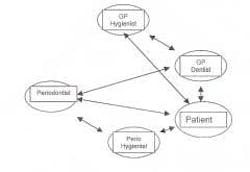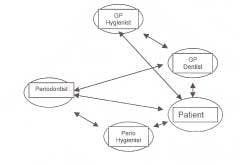13 wonderful syllables
I like words. The words I have liked lately are collaboration, concordance and eudaemonism. Collaboration is a term I like to use instead of compromise. Collaboration brings to mind the phrase "win-win," while its sister word means that everyone loses a little. Concordance is in the same frame as collaboration. It refers to hard-earned agreement between parties. And my favorite word, eudaemonism, (sounds like the word diamond is in there) is a word Aristotle used to describe a level of excellence beyond what we normally think of excellence. Eudaemonism is a striving to an excellence including a happiness that is beyond that of frozen custard or tight gingival tissue. All three are terms we can use in our daily dental hygiene practice with our fellow professionals.
In the dental hygiene world, referring patients usually means referring to the periodontist. A specialist may be necessary if the case is too complex, the patient is medically compromised, the disease could not be brought into remission in our hands, or a small number of other reasons. We are the periodontal specialists in general dental practice, and many times are the care providers who recommend referral to a specialist. Sometimes we look to our employer to do the actual referral; other times we suggest an evaluation by a specialist without directly involving the middleman, bringing him/her up to speed at the end of the day. If done right, we collaborate with our patients, avoid compromise, come to a concordance in treatment planning, and strive to achieve eudaemonism.
Sounds lovely.
Some hygienists in the United States have this kind of relationship with their dentist/employers. Others find it an uphill battle to come to some agreement of what gum disease looks like. Other oral care specialists find it difficult to come to concordance with the periodontists available to treat their patients. The periodontist who taught our periodontology class took great delight in telling us that we now knew more than any dentist in the metro area did. At the time, we all thought it was cool that we had a better handle on periodontal disease than our eventual employers would.
Of course, the reality is that, regardless of whether we did know more than they, we still had to deal with the GP dentist as an employer and dentistry as an industry that oversees ours. Some general practitioners found that their hygienists knew something by attending continuing education courses together. While getting up to speed, some dentists find it easy to collaborate with their hygienists on treatment planing. Other dentists just huff and puff; they went to dental school, you know.
The periodontist, on the other hand, has an entirely different relationship with the referring dentist's hygienists. In most cases it seems to be an invisible relationship. To use the concept of concordance in patient care, the periodontist must collaborate with the referring hygienist. If the correspondence is exclusively between the doctors, we end up having a transfer of information and ideas that leaves out the major players, namely the patient, and the therapist. The parlor game, "Telephone," is a good analogy to describe what can happen with this indirect way of communicating. See if you can follow this diagram. Each arrow signifies information exchange.
The only person getting information from all the sources is the one who has the most passive part in the treatment protocol. Unfortunately, the patient also is the least knowledgeable about treatment options.
The most logical arrows are missing. If the periodontist is having the mutual patient treated by his/her own staff, an arrow connecting the two hygienists should exist. If the periodontist sees the value in having the GP hygienist providing nonsurgical care, then an information arrow should connect them.
How the periodontist communicates with the referring office is amorphous — there is no set convention. It doesn't have to be one particular way. The easiest to document is a letter by the periodontist to the office of the generalist. The letter is stored in the patient's chart where it is accessible to all. It's functional, but it's far from eudaemonism.
The excellence we want to portray to our patients isn't very apparent when the GP hygienist has to dig around in the chart and reconstruct the correspondence between the doctors. Excellence surely doesn't mean that the original care provider doesn't know the foundational elements of the specialist's treatment modalities. Of course, experience will enlighten the off-site hygienist. Experience can be a good teacher of life lessons; it isn't a good teacher of definitive patient care.
A newsletter from the periodontist to the referring office would be a fair way to announce paradigm shifts that occur from time to time. It would also be the most efficient way to let referring offices know that a new treatment modality will be instituted. A newsletter can let all referring hygienists know what the periodontist thinks about certain items that come up in the journals, or his/her perspective on new products. Most hygienists would like to know those things. It makes our job easier when conveying information to our mutual patients.
Newsletters fill gaps
The newsletter can be yearly or more frequent. It can be a task taken on by the support staff rather than the specialist. General hygienists who love perio want to know what the periodontist is doing without bothering them with a phone call. They would like to know if the periodontist has a working relationship with the medical doctors in the area, or if the periodontist is buying into the systemic/perio link. They'd like to know if the doctor they refer to orders blood work on patients with difficult cases. They would like to know of all the patients the periodontist sees, how many had oral cancer, how many had periodontal surgery, and how many escaped surgery by turning around their home care.
The hygienists I know would thrive on this kind of feedback. If the periodontist made it known that his/her patients are routinely screened for diabetes and clotting times, for example, the hygienists who regularly provided periodontal therapy in the general office would refer unruly cases earlier.
Every dental journal has some mention of periodontal disease as a risk factor for diseases far removed from the mouth. The referring periodontist is obligated, by virtue of an advanced specialty education, to let us know what s/he thinks and give guidance to non-specialists.
Orthodontists are not off the hook either. Requests are made to the referring dentist to extract teeth or update ortho treatment plans. A note to the general practice dental hygienist from the orthodontist or support staff about a patient's home care would be a step toward eudaemonism. Collaboration between professionals in the ortho realm would achieve healthier patients and better results.
Sharing changes that may not seem to affect the referring office is helpful. General practice hygienists want to reinforce the same brushing techniques, and recommend the same toothbrushes, fluoride, water jets, or anything else the specialist uses. General practice hygienists should not have to hear it first from the mutual patient. Communication takes time. So does making a diamond. Every second spent on communication is a step closer to an end result worth striving for. In most cases a form letter with check boxes would be satisfactory. Specialists could send batches of letters to save on postage, or fax the information over. When changes occur within a specialty practice, communication to the referring hygienist can reap happy results.
Collaboration, concordance and eudaemonism: 13 syllables to excellent patient care.
Shirley Gutkowski, RDH, BSDH, has been a full time practicing dental hygienist in Madison, Wis., since 1986. Ms. Gutkowski is published in print and on Internet sites, and speaks to groups through Cross Links Presentations. She can be contacted at [email protected].

